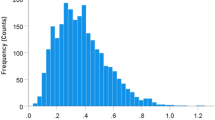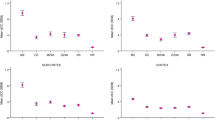Summary
The influence of genetic relatedness on the similarity degree of topographical EEG parameters was studied in a sample of 26 sets of monozygotic (MZ) and 46 sets of dizygotic (DZ) twins. All 144 subjects were healthy, primary school children, aged 7–15 years, 69 boys and 75 girls. Correlation coefficients were calculated for 50 quantitative EEG parameters of paired values obtained at each of 16 active electrode sites, in four groups of paired tracings: 1. MZ twins, 2. DZ twins, 3. The autocorrelated (A) group formed by correlating the spectral parameters from the same subjects in two different analyzed sequences, 4. The random (R) control group of 1200 unrelated pairs formed from DZ twin pairs. Sets of MZ twins and A group showed the highest degrees of similarity of spectral parameters over all brain areas except for significant differences only for some background features over posterior regions. In contrast, highly significant differences in topographic parameters were evident in comparison of MZ sets with DZ sets, particularly when MZ sets were compared with DZ subsets of opposite sex. Both number and degree of significant differences increased progressively in comparisons with groups 3 vs 2,1 vs 4, and 3 vs 4. The data gave strong evidence for a complex polygenic determination of normal human EEG topography.
Similar content being viewed by others
References
Abt, K. Planning controlled clinical trials on the basis of decriptive data analysis. Stat. Med., 1991, 10: 771–795.
Christian, J.C., Pao-Lo, Y., Slemenda, C.W. and Johnston, C.C. Jr. Heritability of bone mass a longitudinal study in aging male twins. Am. J. Hum. Genet., 1989, 44: 429–433.
Davis, H. and Davis, P.A. Action potentials of the brain in normal persons and in normal states of cerebral activity. Arch. Neurol. Psychiat., 1936, 36: 1214–1224.
Dumermuth, G. Variance spectra of electroencephalogram in twins. In: P. Kellaway and I. Petersén (Eds.), Clinical Electroencephalography of Children. Grune and Stratton, New York, 1968: 119–154.
Gasser, T., Verleger, R., Bächer, P. and Sroka, L. Development of EEG of school-age children and adolescents. I. Analysis of band power. Electroenceph. Clin. Neurophysiol, 1988a, 69: 91–99.
Gasser, T., Jennen-Steinmetz, C., Sroka, L., Verleger, R. and Mocks, J. Development of the EEG of school-age children and adolescents. II. Topography. Electroenceph. Clin. Neurophysiol., 1988b, 69:100–109.
Isaksson, A. and Wennberg, A. Spectral properties of nonstationary EEG signals, evaluated by means of Kaiman filtering: application examples from a vigilance test. In: P. Kellaway and I. Petersén (Eds.), Quantitative Analytic Studies in Epilepsy. Raven Press, New York, 1976: 389–402.
Juul-Nielsen, N. and Harvald, B. The electroencephalogram in uniovular twins brought up apart. Acta genet. (Basel), 1958, 8:57–64.
Lennox, W.G., Gibbs, E.L. and Gibbs, F.A. The brain-wave pattern, an hereditary trait. Evidence from 74“normal” pairs of twins. Hered., 1945, 36: 233–243.
Linkovski, P., Kerkhofs, M., Hauspie, R. and Mendlewicz, J. Genetic determinants of EEG sleep — a study in twins living apart. Electroenceph. Clin. Neurophysiol., 1987, 66: 489–501.
Linkovski, P. Genetic influences on EEG sleep and the human circadian clock. A twin study. Pharmacopsychiat., 1994, 27: 7–10.
Lykken, D.T., Tellegen A. and Iacono, W.G. EEG spectra in twins: evidence for a neglected mechanism of genetic determination. Physiol. Psychol., 1982, 10: 60–65.
Lykken, D.T., Tellegen A. and Thorkelson, K. Genetic determination of EEG frequency spectra. Biol. Psychol., 1974, 1: 245–259.
Matouçek, M. and Petersén, I. Frequency analysis of the EEG in normal children and adolescents. In: P. Kellaway and I. Petersén (Eds.), Automation of Clinical Electroencepha-lography. Raven Press, New York, 1973: 75–102.
Meshkova, T.A. Laterality effects in twins. Acta Genet. Med. Gemellol., 1992, 41:325–333.
Noebels, J.L. and Sidman, R.L. Persistent hypersynchronization of neocortical neurons in the mocha mutant of mouse. J. Neurogenet, 1989, 6: 53–56.
Perez-Borja, C., Chatrtian, G.E., Tyce, F.A. and Rivers, M.H. Electrographic patterns of the occipital lobe in man: a topographic study based on use of implanted electrodes. Electroenceph. Clin. Neurophysiol., 1962, 14:171–182.
Raney, E.T. Bilateral brain potentials and lateral dominance in identical twins. J. Exp. PsychoL, 1937, 24: 21–39.
Smith, C. Heritability of liability and concordance in monozygotic twins. Ann. Hum. Genet., 1970, 34: 85–91.
Stassen, H.H. Computerized recognition of persons by EEG spectral patterns. Electroenceph. Clin. Neurophysiol., 1980, 49:190–194.
Stassen, H.H., Bomben, G. and Propping, P. Genetic aspects of the EEG: an investigation into the within-pair similarity of monozygotic and dizygotic twins with a new method of analysis. Electroenceph. Clin. Neurophysiol., 1987, 66:489–501.
Steinlein, O., Anokhin, A., Yping, M., Schalt, E. and Vogel, F. Localisation of a gene for the human low-voltage EEG on 20q and genetic heterogeneity. Genomics, 1992, 12: 69–73.
Sviderskaya, N.E., Korol'kova, T.A. The genetic traits of the spatial organization of the electrical activity of the human cortex (in Russian). Zh. Vyssh. Nerv. Deiat. Im. I. P. Pavlova, 1994, 44: 640–649.
Vogel, F. The genetic basis of the human electroencephalogram (EEG). Hum. Genet., 1970, 10: 91–114.
Author information
Authors and Affiliations
Rights and permissions
About this article
Cite this article
Martinović, Ž.J., Jovanović, V. & Ristanović, D. Computerized EEG topography of normal preadolescent twins—Correlating similarity of background activity with genetic relatedness. Brain Topogr 9, 303–311 (1997). https://doi.org/10.1007/BF01464485
Accepted:
Issue Date:
DOI: https://doi.org/10.1007/BF01464485




